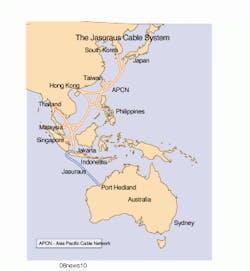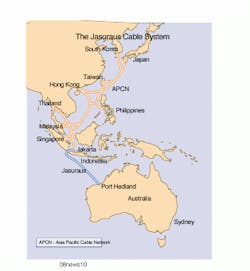Jasuraus links Australia to Indonesia
Jasuraus links Australia to Indonesia
By PAUL MORTENSEN
Australia has inaugurated a 2800-km submarine cable called Jasuraus--its first direct fiber communications link with Indonesia. The A$160 million cable, a cooperative venture among Telstra Corp. Ltd. of Melbourne, Optus Communications of Sydney, and Indonesia`s national carrier, PT Indosat, links Port Hedland in western Australia with Jakarta and other Asian countries.
The new cable has the capacity to transmit 60,000 simultaneous telephone conversations, or 5.332 Gbits/sec (32 ¥ 155.52 Mbits/sec). It consists of one fiber pair and 34 repeaters with a spacing of 82 km, and uses self-healing Synchronous Digital Hierarchy (sdh) technology. Alcatel and Cable and Wireless Marine laid the cable at a maximum depth of 6550 m. Alcatel manufactured the submarine cable at its Port Botany facilities in Sydney.
Jasuraus not only connects Australia to Indonesia but also to the Asia Pacific Cable Network (apcn; see figure). apcn provides access to nine major Asian destinations, with onward connections available through existing or planned submarine cable systems, such as the sea-me-we-3 link, which connects Southeast Asia, the Middle East, and Western Europe.
"Jasuraus is a key element of the infrastructure that will serve to bind the member nations of the region more closely, and into the global community," says Frank Blount, chief executive officer of Telstra.
With Jasuraus successfully completed, Alcatel`s Port Botany facility will turn its attention toward one of the systems expected to expand the reach of Jasuraus traffic. Earlier this year, Alcatel was awarded a contract valued at A$282 million for an extension to sea-me-we-3 (see Lightwave, May 1997, page 7). This new link is owned by 90 telecommunications carriers and will span some 11,000 km when completed at the end of 1998. The additional route through both the South China and East China Seas will increase the total length of sea-me-we-3 to 38,000 km--the longest undersea network installed to date.
The company will supply the undersea system for the southern part of the new network from Singapore to Shantou, China. It will operate in sdh at 2.5 Gbits/sec and use wavelength-division multiplexing. Up to eight wavelengths on each of two fiber pairs can be used, giving a maximum capacity of 40 Gbits/sec (500,000 simultaneous calls) for the transmission of data, video, and voice traffic. Alcatel`s cable manufacturing facilities, including those at Port Botany, will be involved in the manufacture of the cable for the main link and for the new Asian extension. q
Paul Mortensen writes from Australia.The Jasuraus Cable System links Australia with Indonesia, with onward connections to other countries via the Asia Pacific Cable Network. Further links to systems such as sea-me-we-3 are planned.
Japan Funds Fiber R&D
Japanese companies involved in research and development of advanced optical technologies for submarine cables have received more funding. The money is part of the "Total Optical Telecommunications Technology" program aimed at the all-optical transmission of data, imagery, and voice traffic at terabit speeds over a distance in excess of 10,000 km.
Fiscal 1997 (April 1 to March 31) funding for the second year of the 10-year program is 501 million yen--more than US$4.6 million. Early plans envision trials (at an unspecified date) of a transoceanic system forming a network linking Tokyo, Malaysia, Sydney, and Los Angeles.
Main themes of the project are soliton transmission and control technologies, ultrahigh-speed light sources and modulation technologies, ultrahigh-speed multiplexing/demultiplexing technologies, optical fiber for transmitting solitons, optical devices for increasing bandwidth, wavelength-division-multiplexing (wdm) technologies, and optical-signal-processing technologies.
Funding from the government was released to the Telecommunications and Broadcast Foundation, a quasi-governmental organization that solicits proposals for project funding via publication in the Japanese Official Gazette. In fiscal 1996, Oki Electric Industry Co. Ltd., Sumitomo Electric Co. Ltd., Toshiba, nec, Fujikura Co. Ltd., Fujitsu, Mitsubishi Electric, and the Support Foundation for Advanced Telecommunications Technology were funded to work on the project.
Present undersea cables, such as the tpc-5 Cable Network between Japan and North America, use 5- to 10-Gbit/sec single-channel erbium-doped fiber-amplifier systems. But future networks, according to Shigeyuki Akiba, kdd Research and Development Laboratories, Saitama, Japan, will make more use of wdm transmission, add/drop multiplexing (adm), and crossconnect functions in optical path layers. These features can be mixed and matched for networks that emphasize security, survivability, or flexibility. If all of the features are used, he notes, new optical devices such as a tunable adm filter for transoceanic projects will become a reality.

